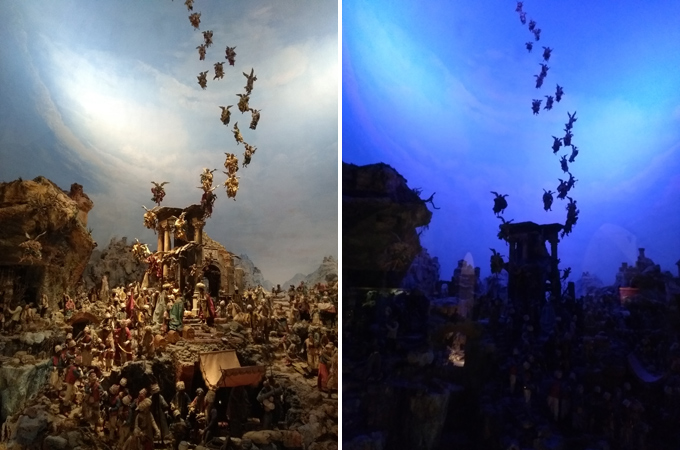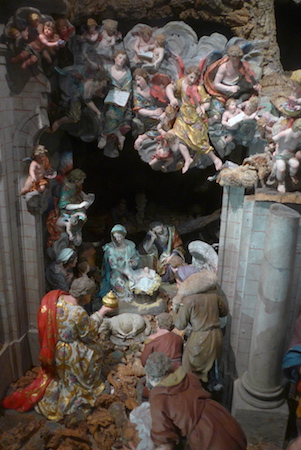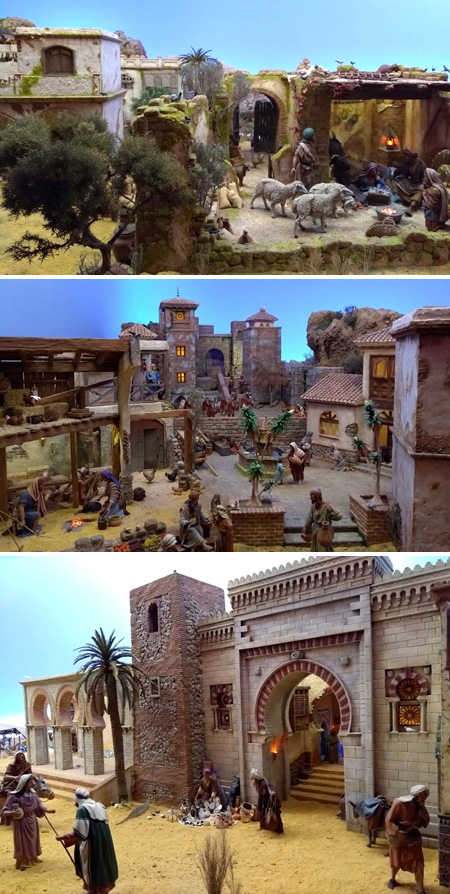
Since early days of Christianity, representations of the birth of Jesus appeared all around the Mediterranean. But on Christmas Eve of 1223 a new trend began which has endured to the present: St. Francis of Assisi placed an empty manger with a donkey & an ox —combining imagery from the Gospel of Luke & the Book of Isaiah— inside a cave in central Italy. After Mass, St. Francis told of the coming of Christ to an awestruck crowd. They could finally see & experience what had only been words before! Soon people began to portray Biblical figures as actors, & a more practical version with figurines carved of wood or sculpted from terracotta developed in time. From these medieval Italian origins, the Nativity scene would become popular centuries later in Spain…

Ferdinand VI inherited the Spanish throne in 1746, but suffered from serious mental disorders & died without an heir. His half-brother had been ruling Naples & Sicily, so when Ferdinand VI passed away Carlos III had to pack up & move to Spain. Revered by historians for his Enlightenment policies, living in Italy made Carlos III very fond of their Christmas traditions… so he brought the Nativity scene (belén in Spanish, from the word for Bethlehem) with him. Belenes could be found in Spanish churches before the arrival of Carlos III —notably by one of the first women sculptors, La Roldana— but their popularity skyrocketed with the new royal family. Aristocrats imitated the king & common people imitated the aristocrats. Soon everyone in Spain loved Nativity scenes.
To get an idea of how popular Nativity scenes remain in Naples, take a stroll down Via San Gregorio Armeno & marvel at all the vendors. Attention to detail is amazing. Also, the crèche collection of San Martino monastery has a permanent display of locally made Nativity scenes… even a gigantic one with changing lights to show the passage of time. It’s easy to understand why Carlos III adored this tradition:

In Catholic countries, two distinct types of belén have developed over the centuries. Many wealthy families commissioned important artists to design a static, self-contained scene which fits neatly into its own special-made box, storage cabinet or closet. Although gorgeous works of art, they lack the ability to change with the times & may appear outdated after a few generations. More innovative & flexible open scenes are displayed as a diorama, lower than eye level & with a variety of compositions created by different sized figures (to maintain perspective), buildings of all types & often live greenery. Open displays invite viewers to stop, ponder details & immerse themselves in the scene.

One further distinction can be made among the style of Nativity scenes. Biblical scenes faithfully recreate how Palestine looked over 2,000 years ago with period dress & customs. No innovation but lots of detail. Regional scenes are my personal favorite, just as they were for Carlos III. With no resemblance to Palestine at all, Mary & Joseph are set in local places familiar to the viewer & often with modern dress. Figures in Baroque formal wear thrilled Carlos III while I prefer reproductions of ranches from Andalucía, complete with olive & orange trees. These scenes demonstrate an amazing syncretism, blending old & new to make the birth story more relatable to viewers. Finally, modern scenes take time-warp to an extreme. Figures are often mere shapes with few human characteristics, little adornment & can even be made of recycled material… much like a modern art exhibit.





Living in Spain means Rafa & I have our own belén at home that takes center stage each Christmas. My husband, being such a crafty person, has made the entire scene himself & spent years collecting figures from a particular sculptor. Of course the composition changes as days progress: Mary & Joseph find shelter, Jesus is placed in the manger at midnight on Christmas Eve, & the Three Wise Men arrive with gifts as Epiphany approaches.
Since we both love Portugal, his Nativity scene is set in Lisbon with Alfama streets, city fountains, tile-covered buildings, a Baixa reconstruction project after the 1755 earthquake & a copy of the Igreja da Memória… there’s also a corner of the Mosteiro dos Jerónimos not on display this year. We’ve run out of room! He always adds something, makes a new market or thinks of a new arrangement. I shudder to think how much it would grow if we had a larger sideboard!

For non-Catholics like myself, a great way to relate to Nativity scenes is to think about opening a box of treasured, family ornaments to decorate the Christmas tree. That same feeling is exactly what families in Spain experience when unwrapping figures & scenery for a belén. Like so many Spanish traditions, emotions experienced around religious holidays often transcend faith. Enjoy the season & visit Spain next Christmas!

What a remarkable bélen you have, Robert! Stunningly beautiful. Your place could be a Presépios Museum!
Thank you so much for sharing it on your blog. Wonderful Southern European tradition that many of us who live in the diaspora try to replicate as far away of North America.
Wishing you and Rafa a very Feliz Natal. Enjoy your festivities.
Abraço,
Emanuel (Toronto, Canada)
Thanks for the comment, Emanuel! Rafa should work as a professional belenista… maybe one day! Feliz Natal to you & your entire family. Abraço grande!!